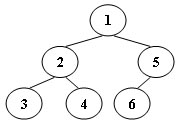树3 Tree Traversals Again 代码
作者:互联网
An inorder binary tree traversal can be implemented in a non-recursive way with a stack. For example, suppose that when a 6-node binary tree (with the keys numbered from 1 to 6) is traversed, the stack operations are: push(1); push(2); push(3); pop(); pop(); push(4); pop(); pop(); push(5); push(6); pop(); pop(). Then a unique binary tree (shown in Figure 1) can be generated from this sequence of operations. Your task is to give the postorder traversal sequence of this tree.

Figure 1
Input Specification:
Each input file contains one test case. For each case, the first line contains a positive integer N (≤) which is the total number of nodes in a tree (and hence the nodes are numbered from 1 to N). Then 2 lines follow, each describes a stack operation in the format: "Push X" where X is the index of the node being pushed onto the stack; or "Pop" meaning to pop one node from the stack.
Output Specification:
For each test case, print the postorder traversal sequence of the corresponding tree in one line. A solution is guaranteed to exist. All the numbers must be separated by exactly one space, and there must be no extra space at the end of the line.
Sample Input:
6
Push 1
Push 2
Push 3
Pop
Pop
Push 4
Pop
Pop
Push 5
Push 6
Pop
PopSample Output:
3 4 2 6 5 1
#include <cstdio>
#include <cstdlib>
#include <cstring>
#include <iostream>
#include <stack>
using namespace std;
typedef int elemType;
typedef struct BTreeNode{
elemType data;
int flag;
struct BTreeNode *lchild, *rchild;
}*Bitree;
stack<Bitree> bst;
Bitree tempNode = NULL;
int printflag=1;
void popNode(){
tempNode = bst.top();
bst.pop();
}
void pushNode1(elemType udata){
Bitree T;
T=(Bitree)malloc(sizeof(BTreeNode));
T->data = udata;
bst.top()->lchild=T;
bst.push(T);
T->lchild = NULL;
T->rchild = NULL;
}
void pushNode2(elemType udata){
Bitree T;
T=(Bitree)malloc(sizeof(BTreeNode));
T->data = udata;
tempNode->rchild=T;
bst.push(T);
T->lchild = NULL;
T->rchild = NULL;
}
void initTree(Bitree &T, elemType udata){
T=(Bitree)malloc(sizeof(BTreeNode));
T->data = udata;
bst.push(T);
T->lchild = NULL;
T->rchild = NULL;
}
void pri(Bitree T){
if(T){
pri(T->lchild);
pri(T->rchild);
if(printflag){
printflag = 0;
cout << T->data;
}else{
cout << " " << T->data;
}
}
}
int main()
{
int status=-1, udata, n;
char opin[20];
Bitree T;
//-1 初态
//1 push之后push,在顶的左边
//2 pop之后push,在pop出的元素右边
cin >> n;
for(int i=0; i<2*n; i++){
cin >> opin;
if(!strcmp(opin, "Push")){
cin >> udata;
if(status == -1) initTree(T, udata);
else if(status == 1) pushNode1(udata);
else if(status == 2) pushNode2(udata);
status = 1;
}else if(!strcmp(opin, "Pop")){
popNode();
status = 2;
}
}
pri(T);
//cout << "Hello world!" << endl;
return 0;
}
标签:Again,udata,Bitree,Traversals,Tree,pop,Push,Pop,push 来源: https://www.cnblogs.com/wstnl/p/14702647.html